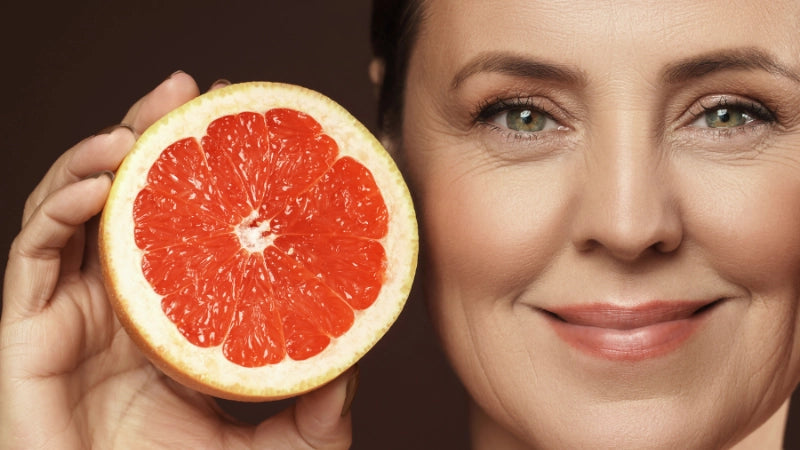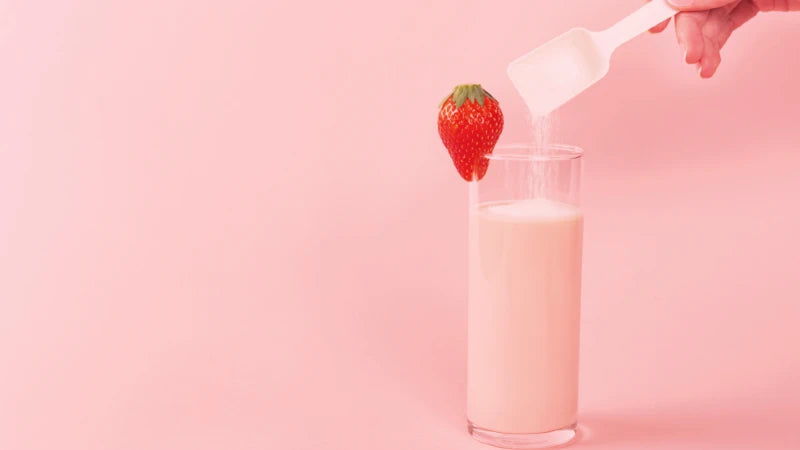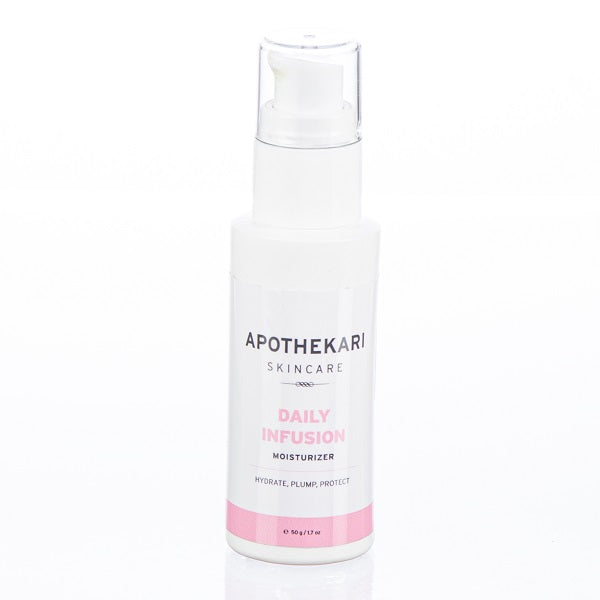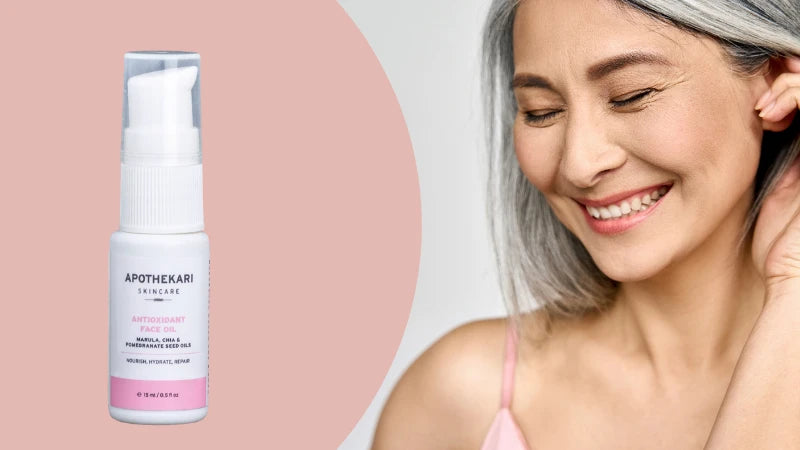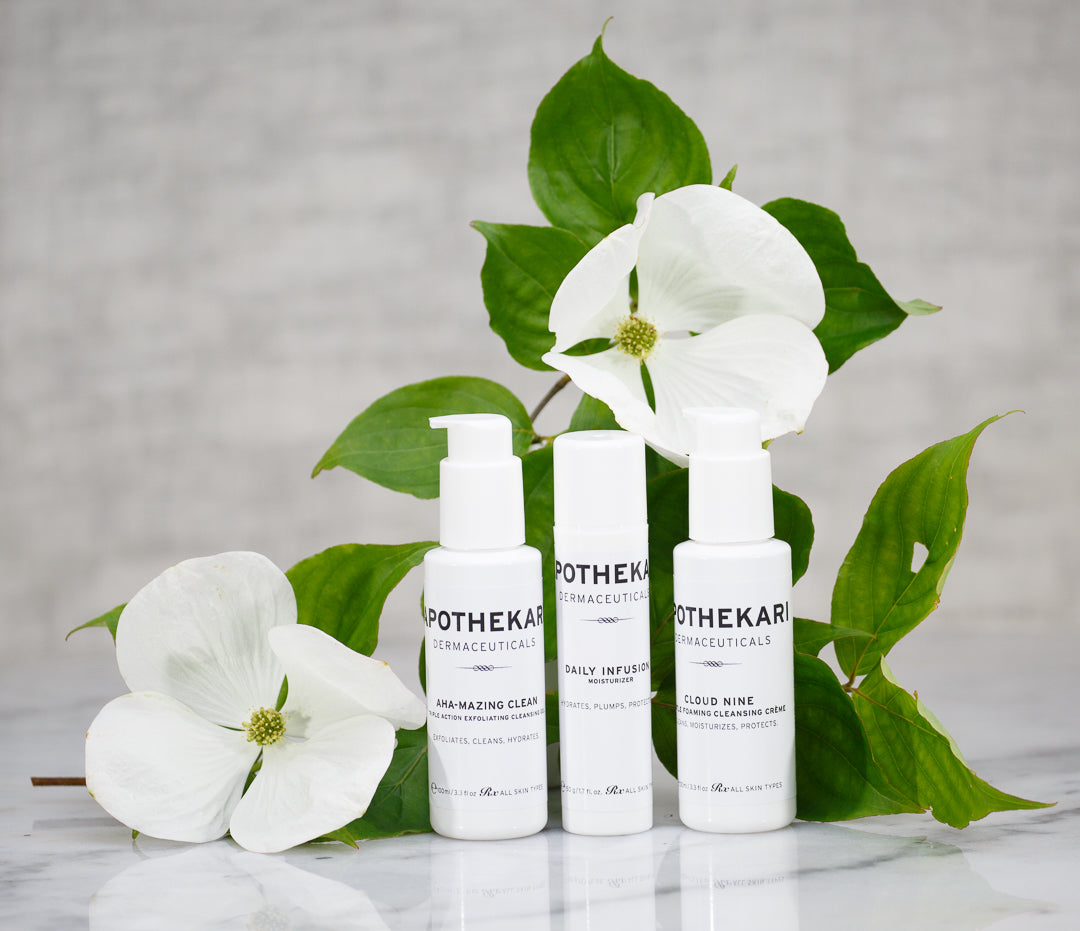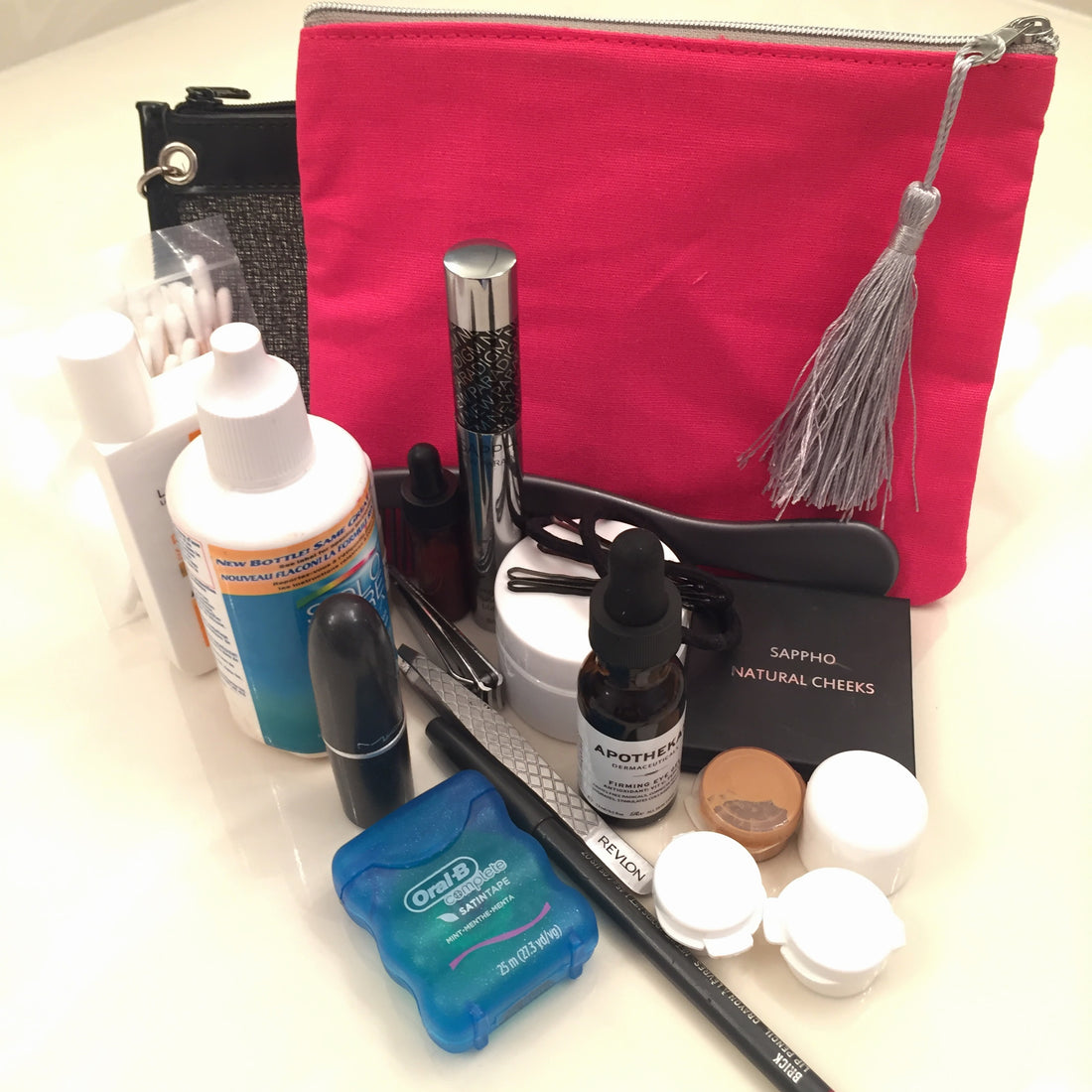Blog
9 Vitamin C Myths You Must Stop Believing
Although it’s a superstar skin care ingredient, there are many vitamin C myths circulating around when it comes to skin care. We’ve written about its benefits before, and in this post, we’re debunking the 9 most common vitamin C myths and setting the record straight. Shop Bespoke Vitamin C 15% Shop Bespoke Vitamin C 10% 1. All vitamin C is the same While the front of your bottle may read as just simply containing vitamin C, in the ingredient list, it can show up as L-ascorbic Acid (pure vitamin C) or other forms including ascorbyl glucoside, magnesium ascorbyl phosphate, ascorbyl tetraisopalmitate, etc. While they are all called vitamin C, they differ in the results they deliver. Plus, each type may be tolerated differently when it comes to your skin. So what type of vitamin C is best? We’re big fans of L-ascorbic acid, because it’s backed by the most amount of research when it comes to its benefits for skin–boosting collagen production; inhibiting melanin synthesis, which contributes to age spots; exfoliating for more glowing skin, etc. It’s what’s in our Glow Getter 15% and 10% Serums. However, if your skin is really sensitive, you may not be able to tolerate L-ascorbic acid, in which case you can look for a formulation made with a different vitamin C derivative. 2. Does vitamin C make your skin sensitive? No, it doesn’t. Vitamin C is acidic, which is why this myth may have gained traction. Vitamin C hasn’t been shown to increase sensitivity to the sun. In fact, studies show that this powerful antioxidant ingredient helps protect against free radical damage from the sun, boosting the protection you get from sunscreen. So, you can apply your vitamin C product in the a.m. or p.m. (or both), depending on what benefits you’re seeking and how it feels in your routine. Daytime application delivers antioxidative benefits, while nighttime application helps more with firming and rejuvenation–though you will also get some of these benefits with daytime application as well. 3. Vitamin C can replace your sunscreen While it’s true that vitamin C helps to protect against the sun’s ultraviolet rays, it is not—and should not be used as—a sunscreen. Vitamin C is one of the strongest defenders against free radicals– unstable molecules that damage skin–and which are caused by exposure to sunlight, pollution and smoke. Think of sunscreen as your first line of defense, helping to block damaging rays, with vitamin C as its assistant, helping to protect against free radicals that make it through the sunscreen’s protection. 4. You can become resistant to it This myth tends to circulate about many skin care ingredients; not just vitamin C. First, it’s important to understand that resistance happens when the number of receptors decrease. Since vitamin C is not active at any specific receptor in the skin, resistance can’t occur. Think of it another way. Vitamin C is not only good for your skin, it’s good for your overall health. If you’re eating nourishing foods every day, chances are that they are high in vitamin C and your body definitely isn’t becoming resistant to the benefits of the strawberries or kale salad that you’re eating on the daily. If a vitamin C formula is working for you, there’s no need to worry that it’s going to stop working. 5. Higher concentrations are always better When it comes to vitamin c myths, this may be the most common one! However, with skin care products, more isn’t necessarily better, because your skin can only absorb so much. Plus, because vitamin C is acidic, higher concentrations can end up being quite irritating. In fact, studies have shown that concentrations of L-ascorbic acid greater than 20% can actually be damaging to skin. As long as you are using a vitamin C treatment from a reputable company, you can feel confident that they’re following guidelines for skin care ingredients that have been established in clinical studies. Whether it’s 0.5%, 1% or 10% doesn’t matter–what matters is that the amount used has been researched to deliver results, without harming skin. 6. Vitamin C can’t be used by sensitive skin Vitamin C can be suitable for all skin types. Is vitamin C ok for sensitive skin? The trick is to find the right type of vitamin C for you. For example, while L-ascorbic acid is the most widely researched–and potent–form of vitamin C, it can also be irritating to sensitive skin. If that’s the case, you can opt for a lower concentration or use it less frequently. If that doesn’t work, then try a form that isn’t so acidic. There are many to choose from, including tetrahexyldecyl ascorbate, magnesium ascorbyl phosphate and ascorbyl glucoside. 7. Vitamin C can’t be combined with other acids, retinol, or niacinamide When it comes to vitamin C and niacinamide, there’s an outdated study that shows the two can potentially react to form nicotinic acid, which can cause skin irritation. However, this potential exists only when pure ascorbic acid and niacinamide are combined together at very high temperatures. Thankfully, it’s not something we need to worry about when it comes to skin care. In fact, pairing these two ingredients can be a winning combination, especially for tackling hyperpigmentation because the two work in different ways to combat discoloration: vitamin C inhibits the production of the pigment responsible for age spots, while niacinamide helps prevent the transfer of the overproduced pigmentation within cells. What about combined with acids or retinol? Vitamin C can be used with retinol, but there is a risk of skin irritation when they are used together. If you want to include both in your skin care routine, we recommend spreading out your actives between your morning and night routine or even between days or weeks. ie vitamin C in the morning and retinoid at night. Can you use vitamin C and AHA (or other acids) together? As with retinoids, your skin can become irritated with these two ingredients are combined. Space them out (morning/night) or alternate the days that you use one or the other. 8. Vitamin C can discolor your skin Vitamin C actually does the opposite! It inhibits the production of tyrosinase, an enzyme that is involved in the production of melanin, the pigment that gives skin its coloring—and which is associated with age spots and hyperpigmentation. The end result is brighter and more evenly toned skin; not discolored skin. 9. DIY vitamin C is a good idea While it’s possible to mix up your own vitamin c serum at home, there are a couple of things to be mindful of: Foods high in vitamin C, like lemon and other citrus juices can lead to phytophotodermatitis, a painful reaction, that can cause skin to blister and break out in drak patches. Don’t do this at home, no matter how many internet searches tell you it’s safe and effective. If you mix your own vitamin C serum, be sure to mix it fresh every day. Vitamin C oxidizes very quickly resulting in a product that may not only be ineffective, but also harmful. Plus, water-based products need preservatives to ensure they don’t become contaminated with baceteria, mold or fungus. Even if refrigerated, they won’t stay fresh for long. We like to think that this is one thing best left to the experts. Did we cover all the vitamin C myths you may have questions about? Let us know in the comments so we can get to more myth busting for you.
Learn moreDo Collagen Skin Supplements Give You More Healthy Skin?
Collagen skin supplements are everywhere these days – are they really the promised ‘Fountain of Youth’, or just more hype? In this post, we’re looking at the research to help you decide if taking a collagen supplement makes sense for healthier skin. Can You Rebuild Collagen in Your Skin? Collagen skin supplements are everywhere these days – are they really the promised ‘Fountain of Youth’, or just more hype? In this post, we’re looking at the research to help you decide if taking a collagen supplement makes sense for healthier skin. When it comes to boosting the production of collagen with skincare products, nothing has more research to support this benefit than retinoids. Derived from vitamin A, retinoids like the gentle, yet effective retinadehyde, found in our A is for Anti-Aging Serum, boost collagen production and help prevent its destruction. Retinaldehyde also increases skin cell turnover, and improves skin tone and texture. And, it helps to minimize oil production, decreasing the appearance of pore size and keeping skin blemish free. Don’t you think it deserves a place in your skin care arsenal? Shop A Is for Anti-Aging Serum (Our Retinoid Formulation) Does Collagen Do Anything for Your Skin? Collagen is a protein and the one most abundant in our bodies. Think of it as the glue that holds everything in your body together keeping your tendons, bones, ligaments, joints and your skin, in good shape. Working in conjunction with another protein, elastin, it also helps to keep your skin looking plump and line free. 75% of the dry weight of your skin is made up of collagen, which is rich in amino acids, the building blocks for protein. Unfortunately, as you get older, your body breaks down collagen faster than you can replace it. External factors like sunlight, pollution and smoking, along with a diet high in sugar and refined carbohydrates, can accelerate its decline and impair its repair. Want to get the glowing skin of your dreams? Subscribe to our newsletter list and download our free guide: 5 Tips to Healthy, Glowing 40+ Skin Is It Worth Buying Collagen Supplements? How to Choose One Collagen skin supplements have been promoted as a way to help make up for the loss that you experience as you age. But do they work? A 2019 literature review in the Journal of Drugs in Dermatology found some data to support that collagen could increase skin elasticity, collagen density and overall hydration.* Additionally, supplementation has been shown to help with arthritis pain and sports related joint pain. Many experts believe that the data is promising. And while they are noticing patient benefits, they’d like to see more studies before giving supplements a firm thumbs up. There don’t seem to be any downsides associated with the use of collagen skin supplements so if you’re interested in giving them a try, here are some tips on finding one that’s safe and effective: Look for a high quality source to ensure lack of contamination from heavy metals. The USP and NSF labels in the USA or an NPN number in Canada, mean that the product has been reviewed to meet safety and quality standards. Buy from a reputable company. Do they follow standards like Good Manufacturing Practices (GMP)? Do they offer good customer service policies? Organic, grass fed or pastured may be a good idea, to minimize the risk of BSE. Wild caught fish is another great source. Seek out hydrolyzed collagen or collagen peptides, which are collagen proteins that have been broken down into smaller, more easily absorbed forms. What About Vegan Collagen? Vegan collagen sources don’t exist. However, plant based foods, like spinach, beans, soy, avocados and sunflower seeds, can help to boost your body’s production of collagen. Foods high in vitamin C also play a role in collagen production. Does Collagen Cream Really Work? Since ingesting collagen shows promise, you may think that it’s a good idea to apply it topically. Not so fast! Collagen is a large molecule and while it’s a great moisturizing ingredient, it doesn’t absorb well into skin and cannot replenish lost collagen. The best way to boost collagen production in skin is by using a topical retinoid, like the retinaldehyde found in our A is for Anti-Aging Serum. It works to help boost collagen levels in the skin by increasing the lifespan of collagen, as well as by blocking certain enzymes that destroy collagen. In addition, retinaldehyde can also help facilitate skin cell turnover, improve skin tone and texture, even decrease the appearance of pore size. How Do You Preserve Collagen in Your Skin? These tips will help to prevent collagen degradation: Wear sunscreen every single day to protect skin against UV rays, which break down collagen fibers Consider adding in peptides to help stimulate collagen and elastin production in the skin Use a vitamin C serum, which also helps to boost collagen production *J Drugs Dermatol. 2019 Jan 1;18(1):9-16. Oral Collagen Supplementation: A Systematic Review of Dermatological Applications (Franchesca D. Choi, Calvin T. Sung, Margit L.W. Juhasz, Natasha Atanaskova Mesinkovsk)
Learn more3 Foods to Avoid For Your Skin During The Holidays
Some foods are just better for our health than others – here are 3 foods to avoid when it comes to your skin and your overall wellness during the holidays this year. While the relationship between flawless, glowing skin and diet isn’t yet crystal clear, there is some evidence linking specific foods to skin flare-ups and other nutrient-rich foods to skin benefits. Learn more in this post. SHOP RADIANT SKIN SET What Food Should Be Avoided For Skin? (Sugary Treats!) Beautifully decorated cookies, holiday chocolates & decadent macarons are in abundance at this time of year. Though they may taste good going down, over consumption can lead to glycation, resulting in the formation of advanced glycation end products (AGEs), which can induce free radical damage and cause deterioration of the skin. The end-result? A loss of elasticity and the development of fine lines and wrinkles. Sugar has become one of the most vilified foods for its negative impact on overall wellness, including our skin’s appearance. We’re not saying never, but try to limit your servings when possible. Or, indulge a sweet tooth with a small amount of fresh fruit or dark chocolate. 2 More Foods to Avoid: Alcohol & Salty Foods Alcohol and salty foods cause dehydration, which can leave skin looking pasty, puffy and more visibly wrinkled. Boozy holiday cocktails often contain a lot of sugar (see above), which can exacerbate the signs of skin aging. These are two foods to avoid when it comes to your skin; moderation is key. Reach for the water, a mocktail or a spritzer when it comes to beverages and load up on crudites instead of the chips. These choices will help to ensure you stay hydrated while nourishing your body with essential vitamins and minerals. What Foods Make Your Skin Better? It’s well known that certain nutrients are essential to good health. Minerals like magnesium and calcium; vitamins A, B, C and D; omega-3 fatty acids; lean protein; fibre; micronutrients…the list goes on. For healthy skin, the research isn’t so clear. But, given that it’s the body’s largest organ, it makes sense that what’s good for the body, is (in general) what’s good for the skin. A diet that keeps your inside healthy will help deliver glowing and beautiful skin as well. The occasional splurge isn’t going to ruin your complexion, but a consistently poor diet is bound to have implications. Several experts whose expertise straddles both nutrition and dermatology are here to tell you which foods may support smooth, healthy skin, and which foods are more likely to lead to rashes, blemishes, and breakouts. Try to Maintain Your Skin Care Routine Wherever Possible Work parties, family gatherings and extra social outings put temptation in front of you during the holidays and it’s only human nature to indulge. Have a sugar cookie, enjoy a glass of eggnog and try that new cheese your cousin bought just for you. It’s important to enjoy life too! While late nights and an over extended social calendar can disrupt routines, try to exercise, get enough sleep and choose healthy food options when you can for the health of both your skin and your body. When it comes to your skin, don’t neglect to cleanse your face before falling into bed. This will help to remove dirt and makeup that can lead to clogged pores and breakouts. Besides cleansing, if there are only two things you can remember to use, make it the serums in our Radiant Skin Set. It includes our Bespoke Vitamin C Serum (for morning) and our A is for Anti-Aging Serum (for night), which will help to protect against inflammation and free radical damage and deliver the glowing skin you want to show the world for the holidays! SHOP RADIANT SKIN SET Happy Holidays All!
Learn moreA Light Face Moisturizer for Warmer Weather
If you’re looking for a face moisturizer for warmer weather, Apothekari Daily Infusion Moisturizer may be just what you’re looking for. In this post we’re discussing tips to help you find one that’s just right for your skin. Want information about moisturizers in general? Check out this post we wrote earlier. Shop Daily Infusion Moisturizer A face moisturizer is a product that we apply to skin to relieve dryness and make it feel more comfortable. They can range from lighter serums and lotions to heavier and thicker treatments such as petroleum jelly (although this isn’t something we’d recommend!). Water qualifies as a moisturizer, but because it evaporates quite quickly, it’s not very effective on its own. The ideal face moisturizer falls somewhere in between water and petroleum jelly and many customers find that a product like Apothekari Daily Infusion Moisturizer works perfectly for them all year round because it moisturizes without leaving skin feeling greasy. It’s also suitable for all skin types. Moisturizer Ingredients Moisturizers are made up of three main types of ingredients: Humectants. Deliver moisture to skin by either grabbing it from the environment or pulling it from the skin’s deeper layers (dermis) to its surface layers (epidermis). Hyaluronic acid (sodium hyaluronate), glycerin, propanediol, honey and propylene glycol are all examples. Emollients. Soften and smooth skin by filling in the gaps. May also lock in moisture. Fats and oils like vitamin E, cholesterol, jojoba oil and some silicones are emollients. Emollients may also have occlusive action. Occlusives. Work by forming a thin, oily layer over skin, helping to lock in moisture. They should be applied over damp skin, ideally. Lanolin, beeswax, petroleum jelly and fatty alcohols like cetyl alcohol and stearyl alcohol are occlusive. Some occlusives may also have emollient activity. The combination and amounts of each ingredient influence how light or heavy a moisturizer feels. A Face Moisturizer for Warmer Weather Humidity (the amount of moisture in the air) changes depending on where you live or the season. Tropical locations and summer often bring higher humidity while winter and desert or cooler climates tend to be drier. A heavy moisturizer (one with more emollient and occlusive ingredients) that was perfect for cooler winter temperatures may feel too heavy now. If you find that your skin is left feeling greasy or oily now that it’s warmer outside, it may be time to revisit the moisturizer you’re using. Opt for one that contains fewer occlusive ingredients and that contains more humectant ingredients. Our Daily Infusion Moisturizer has a good balance of humectants (glycerin), light emollients (caprylic/capric triglyceride, coco-caprylate/caprate, squalane) and occlusives (cetearyl alcohol, cetearyl glucoside, glyceryl stearate) to deliver light moisture that all skin loves. We refer to it as the ‘Goldilocks of Moisturizers’ because most of our customers feel it’s just right! Tips: In order to maximize the effectiveness of your moisturizer, keep the following in mind: Apply over damp skin to lock in moisture. Moisturize as often as you need to. Don’t forget sunscreen to help protect skin against damage from UV rays. Now you and your face are ready for summer!
Learn moreCurious About How to Use a Face Oil? 4 Tips
If you’re curious about how to use a face oil, you’re not alone. They’re are cropping up everywhere these days and just in time for cooler temperatures and lower humidity, when our skin suffers more from dryness, we’ve just introduced our new Apothekari Antioxidant Face Oil. Formulated with Olkerii Marula Oil plus other skin nourishing vegetable oils including chia, pomegranate seed and crambe seed along with essential oils, it delivers fatty acids, sterols and antioxidants to calm, heal and protect skin. It is fast absorbing, suitable for all skin types and formulated to promote soft, radiant skin, protect skin from dehydration, while encouraging skin rejuvenation and reducing inflammation. Customers are telling us that they love our face oil because it has a light emollient (skin smoothing) effect without any greasiness. And they are raving about its divine scent. Shop Antioxidant Face Oil How to Use a Face Oil Depending on the formulation of your oil, it can be suitable for all skin types. That’s a topic for another post, but in this post I’m sharing some tips on how to use a face oil in order to maximize its benefits. Face oils provide emollient and/or occlusive (blocking) action making them ideal to help moisturize skin, but they can’t do it all by themselves. They DON’T hydrate skin. Despite what you may have been told, face oils are not moisturizing. For that effect, you need a product that contains water or a humectant – ingredients that help to increase or draw moisture to the skin. This includes ingredients such as glycerin, propanediol or sodium hyaluronate/hyaluronic acid. Face oils work best used in conjunction with ingredients and/or products that can hydrate skin such as moisturizers and or serums. Less is more. You don’t need to apply a lot—just a few drops are enough to deliver the benefits. When Should I Apply Face Oil to My Routine? Apply as the LAST step in your skin care routine. Many individuals have told me that they apply a face oil as the FIRST step in their routine after cleansing. Due to their occlusive effects, face oils are best applied over top of a hydrating product like a moisturizer or serum to help prevent evaporation, lock in the moisture and ensure that it reaches the skin’s deeper layers. If you’re not using Apothekari Antioxidant Face Oil, are you using another? Do tell.
Learn more5 Holiday Skin Care Tips
Here we are, almost at mid-December and for most of us, the festive season is in full swing. While we may love the lights, the gatherings and the abundance of good food, they can all come with a price. We’re probably eating too much (and maybe not that well), imbibing in alcohol more frequently and also not getting enough sleep. Shop All Apothekari Your skin may be showing its displeasure with your lack of care and indulgences but thankfully, there are ways to disguise what we’ve been up to. Here are 5 holiday skin care tips to help you and your skin survive: 1. Keep Clean Yes, I know. After a late night out, possibly wearing gorgeous but deathly uncomfortable heels, all you want to do is fall into bed. Yet, if you don’t take the time to remove your makeup and wash your face, problems will arise. A dirty face, especially combined with too much alcohol, poor food choices and not enough sleep will lead to breakouts and blemishes. And this is just the time of year when you don’t need them. 2. Sleep While there tend to be many late nights during the holiday season, strive for early nights when you aren’t going out. This one little thing will impact not only how your skin looks but also your overall wellness. 3. Add Some Shimmer Now may be a good time to seek out a good highlighter or shimmer powder. There are many options to choose from and a shimmer powder will add some sparkle to your face. Often infused with light-reflecting particles, you’ll be left with a luminous, radiant look that hides what you did last night! 4. Put On a Concealer If you’ve been out too much or up too late, an under eye concealer can help to hide the dark circles that accumulate from lack of sleep. This little trick can brighten up and awaken the eye area, making it seem that you had enough shut eye. 5. Try Going Make-up Free Hard when you’re a social butterfly, but on days at home, give your skin a break to give it a chance to breathe and recover. This busy and hectic time is also one of my favourite times of the year. While it’s easy to get caught up in the hustle and bustle, it’s important also to take care of yourself and I hope that these 5 holiday skin care tips are useful. Slow down, take a deep breath and enjoy. It’ll get you to the New Year looking bright and beautiful and ready to take on the world!
Learn moreGentle Skin Care: 5 Tips to Kindness
Many of us think that radiant and healthy looking skin means aggressive treatment with lots of products, yet a focus on gentle skin care may be what your skin really needs. And not just sensitive skin either. All skin types look and feel better when handled with kindness. Shop Cloud Nine Foaming Cleansing Creme The key to a gentle skin care routine is to start with milder products. While there is a place for more aggressive treatments, it’s important to ensure that you don’t overdo it. Too many exfoliants or harsh scrubs used too frequently, can actually strip away your skin’s natural oils and cause micro tears, letting moisture out and allowing bacteria and other external irritants in. The key is in managing the amount and frequency of treatments to maximize their benefits and minimize their risk for skin damage. Practicing Gentle Skin Care Here are 5 ways to show your skin some love: Cleanse. It’s important to cleanse skin, especially at night to get rid of make-up and any dirt that accumulates through the day. Whether you opt for a cleansing oil or balm, a micellar water, an exfoliating cleanser or a cleansing cream, choose one that doesn’t contain harsh surfactants like sodium lauryl sulfate, which strip away your skin’s natural oils and leave it open to dryness and irritation. If you do opt for an exfoliating cleanser, you may not require it every night so consider alternating with a more gentle option. Finally, not everyone needs to cleanse in the morning. If your skin is normal or dry, a warm water splash may be all you need when you awake. We love Apothekari Cloud Nine Foaming Cleansing Creme, which gently cleans while moisturizing and protecting. Hydrate. Ingredients like hyaluronic acid, glycerin and sodium lactate grab on to moisture and help skin retain it, keeping it looking and feeling soft, smooth and supple. You can find hydrating ingredients in moisturizers, serums and toners. Apply Emollients. Emollients are ingredients like shea butter, cocoa butter, argan oil, coconut oil and apricot kernel oil, which are best applied after hydrating ingredients to help to lock in moisture. They can soften, protect and smooth skin. Essential oils – those ones that are often accompanied with a heady fragrance – are not the same and are often associated with skin irritation for many skin types. They are best avoided or used in very small amounts in facial care. Warm Water, Not Hot. Cleanse and bathe with warm water. Hot water washes away your skin’s protective oils, leaving it dry, tight, and itchy. Lower temperature helps keep the protective stratum corneum (the skin’s uppermost layer) from rinsing away. Don’t Touch. Do you ever consider how many times a day you touch your face? Probably more than you think. Between turning door knobs, typing on iPhones and tying shoelaces, our hands come in contact with millions of germs and allergens which can transfer from fingertips onto the skin. Touching can lead to breakouts by spreading P. acnes — the bacteria responsible for inflammation and acne. How do you practice gentle skin care?
Learn moreTravel Toiletry Bag: Santa Fe
Tomorrow I’m heading off on a short break to Santa Fe, New Mexico with my husband, Graham! And while I’m still mulling over which restaurants to eat at (priority and Santa Fe is foodie heaven) and sights to see – definitely Tent Rocks – I’m also planning my packing list. Short trips – in fact, most trips for me these days – involve carry-on luggage. Less costly yes, it’s also more convenient (no lost luggage or waiting at the baggage carousel for pick up) and lighter too. Opting for carry-on means seriously culling the suitcase. No matter how long the trip or the destination, I find that I have a habit of over packing. Carry-on makes me think hard about what I will really need while I’m away. Shop All Apothekari Tent Rocks The weather forecast during our stay in Santa Fe is for mainly warm, sunny days with cooler evenings. For our plane trip both ways, I’ll pile on the layers since I’m always freezing when I travel by air. I run really cold so I’m going to wear my winter coat with a scarf, a sweater, dark denims plus my sneakers. Into my suitcase, I’ll pack clothes I can layer including items to dress things up at night. A casual pair of sandals for daytime plus comfortable booties and warm socks for night. Mixing and matching will be the name of the game! My travel toiletry bag will include the following essentials: Toothbrush Dental floss Travel sizes of the following: Toothpaste Deodorant Shampoo & Conditioner (even though most places stock, some of it is nasty!) Apothekari Shea Body Butter – if I’m traveling somewhere low humidity like New Mexico, my skin will need it. Sunscreen Facial potions – I put these into little sample jars or vials: Apothekari Bespoke Vitamin C Serum Apothekari Daily Infusion Moisturizer Apothekari A is for Anti-Aging Apothekari Firming Eye Gel (small bottle so I take the full size) Sewing kit Tweezers Nail clippers Q-tips Bobby pins & hair elastics Make-up bag. I don’t wear a lot of make-up but this is what goes in it: Foundation (small sample jar) Blush and brush Eyeliner Mascara Lip pencil Lipstick Lip balm – I have a feeling I’ll need some in Santa Fe! With this list, packing won’t take long and there will be plenty of room to bring back a few souvenirs. I hear that Santa Fe is a shopper’s paradise! What does your travel toiletry bag and vacation suitcase look like? Follow along on Instagram or Facebook (links at the bottom of our site) where I’ll be posting shots of my trip (and probably NOT of my travel toiletry bag) while I’m away!
Learn more4 Fall Skin Care Tips
These fall skin care tips are a great way to change up your skin care routine to ensure that you’re using the right products for the season. Much like we change our wardrobe when the weather changes, it’s a good idea to re-examine the products you’re using on your skin too. Shop All Apothekari Summer is fantastic and my favourite season of all so I always hate to say goodbye. Yet, longer and more extensive exposure to UV rays during the warmer months can do a number on skin leaving it more sun damaged and prone to early signs of skin aging. Fall is a great time to evaluate how your skin is looking and feeling. If you need to swap out products by eliminating those that aren’t working with those that are more relevant for your skin care needs now, this is a good time to do it. Here are 4 fall skin care tips to consider when the leaves start to fall and the weather turns cooler: 1. Exfoliate It may seem counter-intuitive but if your skin is looking dry and flaky, a good (gently, though) scrubbing is what you may need. Exfoliation helps to remove dry skin that looks bad but that also prevents topical treatments from absorbing in. Try our AHA-Mazing Clean Exfoliating Cleansing Gel with its triple combination of alpha hydroxy acids and boasting a fresh peppermint scent. Showers and baths are so much more exciting with our Bamboo Lemongrass Foaming Body Polish – a customer favourite! 2. Up the Moisture Cooler temperatures and lower humidity may make additional hydration necessary. Although I can generally get away with a moisturizer during the summer months, my skin often craves a bit more when September rolls around. Daily Infusion Moisturizer hydrates and plumps skin year-round and leaves it feeling refreshed. It’s ideal for all skin types, including sensitive. 3. Fix the Damage If you experienced excessive sun exposure during the summer, your skin may have suffered some sun damage. If you aren’t already using a retinoid, get thee to one pronto! Retinoids, which are derivatives of Vitamin A, help to repair and renew skin and are excellent in helping manage hyperpigmentation and age spots that the sun may have had a part in creating. A is for Anti-Aging is our version, which incorporates gentle yet effective retinaldehyde along with niacinamide, which is a strong anti-inflammatory that helps to calm skin and manage breakouts. 4. Customize We are all different and so we have different skin care needs. If you live along the coast, your skin will require different treatment than someone living on the Prairies or in the Midwest. My skin loves humid, coastal Vancouver but take me to Arizona and I’m parched just like that desert! Keep that in mind as you tailor a skin care regimen that works for you. I hope that the 4 fall skin care tips will help as you transition through the seasons. Do you have any more to share?
Learn moreWhat Makes You Buy Skin Care Products?
As someone who runs a skin care brand, I’m always curious to know what makes customers buy skin care products. There’s no shortage of choice and many outlets – drugstores, department stores, independent boutiques and the internet – to fulfill every possible need. One could peruse for hours, days, weeks, months. Certainly there must be a lot of confusion. What makes one go from looking to committing and finally to pulling the plug to buy skin care products? Shop All Apothekari In a previous post, I wrote about the 4 Steps to Great Skin and I think that most skin care experts would agree to this, with some minor differences. Several skin care products are considered as essential – a good sunscreen and an effective cleanser, for example. And, if you are after skin that looks and feels youthful and that radiates wellness, it’s wise to add in a retinoid and some antioxidants too. Then it’s time to deal with the specifics. If your skin is dry, you’ll need to hydrate with a good moisturizer. Acne? Treat that. Same with hyperpigmentation, skin sensitivity, eye concerns and aging or sun-damaged skin. Once you know what kinds of products you need – a moisturizer, a sunscreen, an eye cream – how do you decide how and where to buy skin care products? Which ones specifically? Which brands? Formulated with which ingredients? What gives you the confidence to try a new skin care product especially if you are mostly happy with your current skin care routine? Who do you trust? These are some of the things that customers have mentioned to me: My dermatologist/esthetician/doctor recommends it. My friends love it and suggested I try it. I’ve heard about it on social media platforms – Facebook, Instagram, Twitter, etc. I like to try before I buy so samples will help to seal the deal I’ve seen an advertisement online, in a magazine, etc. Testimonials. One of the things that helps us find new customers and keeps regular ones coming back are through word of mouth or from the results they’ve had from using Apothekari. From helping to manage acne breakouts to delivering glowing skin, many individuals report receiving compliments on their skin, which they’ve never received before. I LOVE these products. My skin glows. ~India, Vancouver, BC My breakouts have disappeared… ~Sara, Vancouver Thank you for treating my skin so well, Apothekari! ~Karen, Vancouver, BC Happy customers make us happy too! Do testimonials help you to buy skin care products? Read more testimonials here. If you’re curious about Apothekari Skincare and have questions, don’t hesitate to call us – 1.866.876.3649 or email us info@apothekari.com. We love to talk skin care and would be happy to discuss your needs!
Learn moreBe Kind to Skin: 5 Tips
When it comes to taking care of our skin, we often discuss the importance of removing make-up, exfoliating and applying active treatments to make it look more youthful and healthy. Marketing has led us to believe that when it comes to our skin, we must continually defend against time. It’s not surprising then, that the concept of how to be kind to skin may be overlooked. Many skincare steps are undoubtedly beneficial, but it’s important to keep in mind that it’s possible to overdo it. Using too many products, aiming for ‘squeaky clean’ and over-exfoliating can irritate and inflame your skin leading to clogged pores, blemishes and redness. Shop All Apothekari Here Are 5 Tips on How to Be Kind to Skin: 1. Opt For Gentle Cleansers Stay away from fragrances and avoid harsh cleansing agents such as sodium laureth sulfate, which strip away skin’s natural oils and disturbs the skin’s acid mantle, leaving it feeling tight and dry. Our Cloud Nine Foaming Cleansing Crème is a terrific option for all skin types. 2. Go Bare-Faced Like many women I know, I rarely leave the house without at least a lick of lipstick. But, I appreciate the freedom of giving my skin a break, especially from foundations, powders and other heavy make-up. Cosmetics have come a long way in the last few years, so chances are that your makeup isn’t causing your skin great distress. However, it’s not a bad idea to skip the makeup once in awhile, especially if you are prone to clogged pores. 3. Don’t Over-Exfoliate There is no need to scrub hard when exfoliating. Chemical exfoliants like alpha hydroxy acids – AHAs – and beta hydroxy acids – BHAs – work by ‘dissolving’ dead, dry cells at the top of the skin’s surface so there is little need to scrub. If you opt for manual exfoliation, be kind to skin and stick with ingredients like jojoba beads and ditch the hard, jagged kernel shells, which can cause micro tears in your skin leading to irritation, breakouts and increased skin sensitivity. Use soft, light movements, and exfoliate no more than once every two to three days. 4. Touch Gently Don’t handle your skin roughly or rub abrasively. This means not picking at blemishes, not rubbing too hard and not being aggressive when removing eye make-up. 5. Consider Silk It may sound indulgent but there are those who claim that sleeping on silk pillowcases can benefit your skin (and hair). I have yet to come across any studies that support this claim, but the thinking is that the gentle nature of silk means less rubbing against an abrasive surface, which can lead to smoother and softer skin. You’re also less likely to wake up with sleep wrinkles, which means you could be fighting off real wrinkles for a bit longer. I’m not giving this one a firm thumbs up just yet, but in the interest of being kind to skin, it is worth considering, isn’t it?
Learn more

